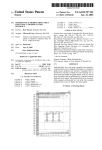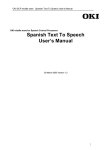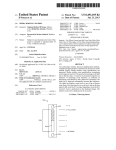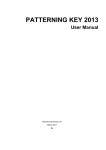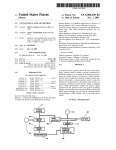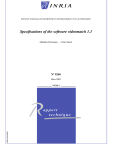Download Computing device having instructions which access either a
Transcript
US006795911B1 (12) United States Patent (10) Patent N0.: US 6,795,911 B1 (45) Date of Patent: Sep. 21, 2004 Miyano (54) COMPUTING DEVICE HAVING INSTRUCTIONS WHICH ACCESS EITHER A 5,895,481 A * 5,937,199 A * 6,260,101 B1 * PERMANENTLY FIXED DEFAULT MEMORY BANK OR A MEMORY BANK SPECIFIED BY AN IMMEDIATELY PRECEDING BANK SELECTION INSTRUCTION (75) Inventor: T0m0mi Miyano, Miyazaki (JP) FOREIGN PATENT DOCUMENTS JP 7-191906 JP 7-234818 9/1995 JP 7'325757 12/1995 7/1995 OTHER PUBLICATIONS (73) Assignee: Oki Electric Industry Co., Ltd., Tokyo (JP) 4/1999 Yap ............................. .. 711/5 8/1999 Temple ........ .. 710/262 7/2001 Hansen et al. .............. .. 710/22 Intel Corporation, iAPX 86/88, 186/188 User’s Manual— Hardware Reference, 1985, pp. 1—1 and 1—7 to 1—10.* (*) NOtiCéI subject'to any diSClaiIIlfIr,~ the term Of this Harvey, RE, 8086 Processor Registers, http://web.archi patent 1S eXIended 0r adjusted under 35 ve.org/web/19991111090421/http://ourworld.compuserve U.S.C. 154(b) by 0 days. .com/homepages/riharvey/docicpu.htm, 1999* * (21) Appl. N0.: 09/493,157 (22) Filed: (51) Jam 28’ 2000 . Primary Examiner—Eddie Chan Int. Cl.7 .......................... .. G06F 12/00; G06F 9/00 (52) US. Cl. ..................... .. 712/225; 712/208; 7127/2285; of Search ............................... .. Assistant Examiner—David J. Huisman (74) Attorney, Agent, or Firm—Volentine Francos, PLLC (57) ABSTRACT A computing device accesses 712/208; 711/5, 157, 148, 173 _ (56) . ‘med by exammer memory banks, which are selected by a bank selection instruction. The memory bank selected by the bank selection instruction is References Clted accessed by a memory access instruction immediately fol U~S_ PATENT DOCUMENTS lowing ' the bank selection instruction. Following any instruction other than the bank selection instruction, a 4,028,675 A * 6/ 1977 Frankenberg ------------- -- 365/222 default memory bank is selected automatically. This scheme 45277261 A 7/1985 eliminates : Smlther - - - - - - - - - - - - - - ~~ 333/12 4,601,018 A 5’OO1’626 A * 7/1986 Balm} et a1‘ """"""" " 365/200 3/1991 Kashlyama et a1‘ """"" " 712/4 5,193,169 A 3/1993 * 5,655,099 A * 5,751,988 A * Ishikawa ............. .. the need to select the default memory bank explicitly, and the need to save and restore the contents of a bank selection register when interrupts are served 710/22 ' 8/1997 Bjerge et al. 711/2 5/1998 Fujimura .................. .. 711/220 8 Claims, 4 Drawing Sheets 5 2 f I ‘,3 REGISTER 1o BANK 4.\__ A0 —A15 A1s-A19 BANK A16-A19 COL'I'JEOL 16 INSTRUCTION OOOOOH 10000H BANK 0 BANK 1 7000OH MEMORY I "" BANK 7 INSTRUCTION DECODER I 6 L ACCUMULATOR S 14 I , OFFFFH 1FFFFH vo PORT # 7FFFFH J 12 Do-D15 U.S. Patent Sep. 21, 2004 Sheet 1 014 US 6,795,911 B1 FIG. 1 OOOOH A BANKO FFFFH OOOOH BANK1 FFFFH OOOOH BANK2 FFFFH OOOOH BANK3 FFFFH 64 KBYTES x 8 BANKS OOOOH BANK4 FFFFH OOOOH BANKS FFFFH OOOOH BANK6 FFFFH OOOOH BANK? FFFFH , U.S. Patent Sep. 21, 2004 Sheet 3 014 US 6,795,911 B1 FIG. 3 1 3° L 8 CK CLR BEN CLK '__'— BDIS 28 24 A16-A19 26 / A16'A19 US 6,795,911 B1 1 2 COMPUTING DEVICE HAVING INSTRUCTIONS WHICH ACCESS EITHER A PERMANENTLY FIXED DEFAULT MEMORY BANK OR A MEMORY BANK SPECIFIED BY AN IMMEDIATELY PRECEDING BANK SELECTION INSTRUCTION The invented method of selecting a memory bank includes the steps of: selecting a memory bank speci?ed by a bank selection instruction for use by the next instruction executed after the bank selection instruction; and automatically selecting a predetermined default memory bank folloWing execution of any instruction other than the bank selection instruction. BACKGROUND OF THE INVENTION The invented computing device has a bank register storing The present invention relates to a computing device such a value specifying one of a plurality of memory banks, and as a microprocessor employing a memory divided into a bank control unit operating in a ?rst state and a second banks. state. In the ?rst state, the bank control unit selects the Microprocessors capable of addressing multiple memory banks are Well knoWn in the computing art. The instruction set of a microprocessor of this type includes a bank selection instruction that sets a bank address in a bank register. Memory access instructions specify addresses that can apply 15 memory bank speci?ed by the bank register. In the second state, the bank control unit selects the predetermined memory bank. BRIEF DESCRIPTION OF THE DRAWINGS to any bank. When a memory access instruction is executed, In the attached draWings: the address speci?ed in the instruction is combined With the value in the bank register to generate an address specifying both a particular memory bank and a particular location in that memory bank. If the softWare running on the microprocessor is of the FIG. 1 illustrates a memory divided into banks; FIG. 2 is a block diagram of a microprocessor embodying the present invention; FIG. 3 is a more detailed block diagram of the bank multitasking type, different tasks or processes may use different memory banks. Typically, each process begins With 25 a bank selection instruction that sets the address of the cessor. desired bank in the bank register. If necessary, the bank selection instruction can be executed again during the pro DETAILED DESCRIPTION OF THE INVENTION cess to sWitch banks. If one process interrupts another, the bank register contents are saved onto a stack, and restored An embodiment of the invention Will be described With reference to the attached draWings, in Which like parts are When the interrupting process ends, so that the interrupted process can resume use of the correct bank. indicated by like reference characters. FIG. 1 illustrates a memory divided into eight banks, An advantage of this scheme is that the memory address space can be expanded beyond the siZe that can be addressed by any one memory access instruction, Without increasing the bit length of the memory access instructions. numbered from Zero to seven. Each memory bank has addresses from OOOOH to FFFFH, the H suf?x indicating hexadecimal notation. These addresses are speci?ed by sixteen address bits. Each memory bank has a capacity of A disadvantage, hoWever, is that saving and restoring the contents of the bank register delays the sWitchover from one process to the other. This is a particular disadvantage in 40 real-time control systems requiring quick response to inter sixty-four kilobytes. FIG. 2 shoWs a microprocessor 1 embodying the present invention, using the bank memory shoWn in FIG. 1. The microprocessor 1 comprises a processing unit 2 With an rupts. A further disadvantage is that every process must set the bank register to be sure that memory accesses Will be directed to the correct bank. There may be, for example, many short processes that use only one memory bank, all sharing the same memory bank. Each of these processes must still start by executing the bank selection instruction, control unit in FIG. 2; and FIG. 4 is a block diagram of a conventional micropro internal instruction memory 4, an instruction decoder 6, a 45 bank register 8, a bank control unit 10, a data input/output (I/O) port 12, an accumulator 14, and various other facilities (not visible). The processing unit 2 is coupled to the eight memory banks 16 by an address bus carrying sixteen address bits A0 to A15, an additional address bus carrying four more address bits A16 to A19, and a data bus carrying sixteen Which adds an unnecessary instruction to the process code and further delays the start of the process. parallel data bits D0 to D15. The tWenty address bits from A0 to A19 have values from OOOOOH to OFFFFH, identifying These disadvantages could be overcome by adding bank selection bits to the memory access instructions, enabling be incompatible With existing instruction sets, requiring locations in memory bank Zero, through 70000H to 7FFFFH, identifying locations in memory bank seven. The memory banks 16 are part of the microprocessor I, prefer ably being integrated onto the same semiconductor substrate as the processing unit 2. Incidentally, the term ‘microprocessor’ as used herein also includes computing devices that are commonly referred to as much conversion of existing softWare. microcomputers and microcontrollers. each memory access instruction to specify both a memory bank and a location in the memory bank, but that Would be a highly inefficient solution. Code siZe Would be greatly increased, and extra circuits Would be needed to analyZe the 55 added instruction bits, increasing the siZe and cost of the microprocessor itself. The expanded instructions Would also The instruction decoder 6 decodes instructions received SUMMARY OF THE INVENTION An object of the present invention is to enable a comput ing device to access multiple memory banks Without requir ing all processes to execute bank selection instructions. Another object is to eliminate the saving and restoring of bank register contents. 65 from the instruction memory 4, supplies address bits A0 to A15 to the memory banks, supplies address bits A16 to A19 to the bank register 8, and controls the bank control unit 10. The bank control unit 10 receives address bits A16 to A19 from the bank register 8 and supplies either the received address bits or four bits having a ?xed value of OH to the US 6,795,911 B1 3 4 memory banks 16, depending on signals received from the instruction decoder 6. The four bits A16 to A19 output by the interval, the selector 28 selects the grounded inputs and supplies an A16—A19 address value of 0H, selecting bank bank control unit 10 select one of the memory banks 16. Zero. Three bits Would be adequate, since there are only eight banks, but four bits give the microprocessor 1 the capability The bank designated by the bank register 8 is thus selected only during the execution of the next instruction folloWing to address up to sixteen memory banks. The other sixteen each bank selection instruction. At other times, bank Zero is address bits A0 to A15 specify a location in the memory bank selected regardless of the contents of the bank register 8. Consequently, absent an immediately preceding bank selec selected by bits A16 to A19. tion instruction, a memory access instruction accesses FIG. 3 shoWs the internal structure of the bank control unit 10, Which comprises a set-reset ?ip-?op 20, a pair of AND gates 22, 24, an inverter 26, and a selector 28. The signals received by the bank control unit 10 include a bank output enable signal (BEN), Which is input by the ?rst AND gate 22; a clock signal (CLK), input by both AND gates 22, 24; a bank output disable signal (BDIS), input by the second 10 tion decoder 6 specify sixteen-bit memory addresses, Which the instruction decoder places on the AO—A15 address bus signal lines. These sixteen-bit addresses indicate locations in 15 AND gate 24; and address bits A16 to A119, Which are input by the selector 28. The output terminal of the ?rst AND gate 22 is coupled to the clock (CK) input terminal of the set-reset ?ip-?op 20. The output terminal of the second AND gate 24 is coupled through inverter 26 to the clear (CLR) input terminal of the set-reset ?ip-?op 20. The data input terminal (D) and set input terminal (S) of the set-reset ?ip-?op 20 are coupled to the poWer supply, thus being held Zero. If immediately preceded by a bank selection instruction, the memory access instruction accesses the memory bank speci?ed in the bank selection instruction. A memory access transfers data on the data bus lines D0 to D15 betWeen the selected memory bank 16 and, for example, the accumulator 14, the data passing through the 25 data input/output port 12. Data can also be transferred betWeen the selected memory bank and other facilities (not visible) in the processing unit 2. Memory bank Zero preferably includes memory-mapped special-function registers, memory-mapped input-output When the Q output of the set-reset ?ip-?op 20 is high (‘1’), ports, the interrupt vector table, and other frequently accessed addresses. In typical applications, many processes the selector 28 selects the A16—A19 address bits received from the bank register 8. When the Q output of the set-reset Will need to access only memory bank Zero. These processes ?ip-?op 20 is loW (‘0’), the selector 28 selects the grounded (‘0’) inputs. The selected inputs of the selector 28 become the output address bits A16—A19 supplied by the bank control can be coded using only standard memory-access instruc tions specifying sixteen-bit addresses, Without any bank unit 10 to the memory banks 16. Next, the operation of this microprocessor 1 Will be all eight memory banks 16, Without specifying Which memory bank is to be accessed, but there is no ambiguity. By default, a memory access instruction accesses memory bank at the high (‘1’) logic level. The data output (Q) terminal of the set-reset ?ip-?op 20 is coupled to the selector 28. The set and clear inputs S and CLR are active loW. The selector 28 also has a set of grounded input terminals. memory bank Zero by default. The memory access instructions decoded by the instruc 35 selection instructions at all. The code siZe and execution time of these processes are thereby reduced. Processes that access other memory banks require a separate bank selection instruction each time a bank other described. The microprocessor 1 has a conventional instruction set With a bank selection instruction that Writes desired values than bank Zero is accessed, even When the same bank is of address bits A16 to A19 into the bank register 8. The bank disadvantage, the disadvantage is offset by the advantage accessed repeatedly. While this requirement is a 40 selection instruction also disables interrupts for one instruc tion execution cycle, so that an interrupt received during the execution of the bank selection instruction is not recogniZed until after the next instruction has been executed. Upon decoding the bank selection instruction, besides sending address bits A16 to A19 to the bank register 8, the that these processes can sWitch from another bank to bank Zero Without having to execute a bank selection instruction. Afurther advantage of the invented microprocessor is that When one process interrupts another, the bank register 45 instruction decoder 6 sets the bank enable signal BEN to the high level and the bank disable signal BDIS to the loW level. The clear input terminal of the set-reset ?ip-?op 20 is selection instruction, the memory access instruction to Which the bank selection instruction applies is executed before the interrupt is served, so the interrupt-handling process can alter the bank register contents With impunity. thereby set to the inactive (high) level, and input of the clock signal CLK to the clock input terminal CK is enabled. During the next clock cycle, the high logic level that is constantly received at the data input terminal D is latched in the set-reset ?ip-?op 20, in synchroniZation With the clock signal, causing the Q output signal to go high, thereby Eliminating the saving and restoring of the bank register is a signi?cant advantage in real-time control applications. A further advantage is that the invented microprocessor 55 causing the selector 28 to select the A16—A19 address values received from the bank register 8. Upon decoding any instruction other than the bank selec tion instruction, the instruction decoder 6 sets the bank enable signal BEN to the loW level at, for example, the beginning of the instruction execution cycle, and sets the bank disable signal BDIS to the high level at the end of the instruction execution cycle. The signal output from inverter 26 goes loW for the duration of one high CLK pulse, thereby clearing the set-reset ?ip-?op 20 and forcing the Q output signal to go loW. The Q output signal remains loW until the next bank selection instruction is executed. Throughout this contents do not have to be saved and restored. Even if an interrupt request is received during the execution of a bank operates efficiently regardless of Whether or not there are multiple memory banks, and enables the number of banks to be expanded from one to more than one Without requiring modi?cations to existing softWare. An operating system and other programs coded for a single-bank environment can be used Without change in a multiple-bank environment. For comparison, FIG. 4 shoWs a conventional micropro cessor 30 With multiple memory banks. The conventional microprocessor 30 has the structure shoWn in FIG. 2, Without the bank control unit. The bank register 8 is alWays 65 used to select the memory bank, so even instructions that access bank Zero must be preceded by a bank selection instruction, and the bank register contents must be saved and restored at interrupts. US 6,795,911 B1 5 6 The invention is not limited to the embodiment described above. For example, the memory banks need not all be banks, the computing device also having an instruction set integrated into the microprocessor. External memory banks tion instruction, the computing device further having a bank register storing a value specifying an arbitrary one of the that includes memory access instructions and a bank selec can be accessed in the same Way. plurality of mutually exclusive memory banks, the comput The structure of the bank control unit shoWn in FIG. 3 can be modi?ed in various Ways. For example, the second AND gate 24 and inverter 26 can be replaced by a NAND gate. The set-reset ?ip-?op 20 can be replaced by any type of ing device generating an address upon execution of each memory access instruction, the address being divided into a ?rst part and a second part, the ?rst part and the second part bi-stable circuit that can be sWitched betWeen tWo states. Those skilled in the art Will recogniZe that further varia tions are possible Within the scope claimed beloW. What is claimed is: 10 1. A method of selecting a memory bank for access by a computing device having a memory permanently divided into a plurality of mutually exclusive memory banks, the being mutually exclusive, the ?rst part including at least one ?rst address bit for selecting an arbitrary one of the plurality of mutually exclusive memory banks, and the second part including a plurality of second address bits for specifying addresses Within the arbitrary selected memory bank, the computing device comprising: a bank control unit operating in a ?rst state and a second computing device also having an instruction set that includes state, Wherein in the ?rst state the bank control unit sets said ?rst part of the address to the value stored in said memory access instructions and a bank selection instruction, the computing device generating an address upon execution of each memory access instruction, the address being divided into a ?rst part and a second part, the ?rst part and bank register to select the memory bank speci?ed by the second part being mutually exclusive, the ?rst part bank control unit sets said ?rst part of the address to a including at least one ?rst address bit for selecting the memory bank from among the plurality of mutually exclu sive memory banks, and the second part including a plurality permanently ?xed value to select a permanently ?xed one of the memory banks, Wherein said bank control unit operates in said ?rst state of second address bits used in common for specifying addresses Within any selected one of the plurality of mutu upon execution of each memory access instruction Which folloWs a the bank selection instruction, and ally exclusive memory banks, the method comprising the steps of: Wherein said bank control unit operates in said second the bank register, and Wherein in the second state the state upon execution of each memory access instruction Which does not folloW a the bank selection instruction. (a) upon execution of each memory access instruction Which folloWs a bank selection instruction, setting said 5. The computing device of claim 4, Wherein the bank selection instruction sets said value in the bank register, ?rst part of the address generated by the computing further comprising: device according to the bank selection instruction to select the memory bank speci?ed by the bank selection instruction, and accessing the speci?ed memory bank according to the executed memory access instruction; and (b) upon execution of each memory access instruction Which does not folloW a bank selection instruction, automatically setting said ?rst part of the address generated by the computing device to a permanently 35 40 ?xed value to select a permanently ?xed default memory bank, and accessing the default memory bank according to the executed memory access instruction. 2. The method of claim 1, Wherein said step (a) further comprises the steps of: storing a value speci?ed by the bank selection instruction 45 6. The computing device of claim 4, Wherein the bank control unit comprises: a bi-stable circuit generating a ?rst control value in the ?rst state and a second control value in the second state; and a selector coupled to the bi-stable circuit, having a ?rst input terminal receiving the value stored in the bank register and a second input terminal receiving said permanently ?xed value, selecting the ?rst input ter minal When the bi-stable circuit generates the ?rst control value, selecting the second input terminal When the bi-stable circuit generates the second control value, and supplying the value received at the selected input in a bank register; setting a bi-stable circuit to a ?rst state When the bank selection instruction is executed; and setting said ?rst part of the according to the value stored in the bank register When the bi-stable circuit is in the ?rst state; terminal to the memory banks as said ?rst part of the address. and said step (b) further comprises the steps of: 7. The computing device of claim 4, Wherein the com puting device is a microprocessor. 8. The computing device of claim 5, Wherein the instruc setting the bi-stable circuit to a second state folloWing said execution of each instruction other than the bank selection instruction; and setting said ?rst part of the address to said permanently tion decoder sends the bank control unit a ?rst signal and a second signal, the ?rst signal setting the bank control unit to the ?rst state, the second signal setting the bank control unit to the second, the ?rst signal being output When the bank selection instruction is decoded, the second signal being ?xed value When the bi-stable circuit is in the second state. 3. The method of claim 1, further comprising the step of disabling interrupts during the execution of the bank selec output When any instruction other than the bank selection instruction is decoded. tion instruction. 4. A computing device having a memory permanently divided into a plurality of mutually exclusive memory an instruction decoder decoding the instructions in the instruction set, setting the bank control unit to the ?rst state When the bank selection instruction is decoded, and setting the bank control unit to the second state folloWing execution of each instruction other than the bank selection instruction in the instruction set. 65








